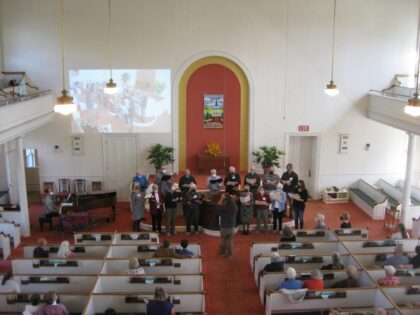Music and Choir
 Music at the First Unitarian Universalist Society of Burlington reflects the diversity of our community, our city, and our world. It is an important and enriching part of life at FUUSB.
Music at the First Unitarian Universalist Society of Burlington reflects the diversity of our community, our city, and our world. It is an important and enriching part of life at FUUSB.
Music Director James Stewart’s approach to programming for the Adult Choir could be described as “Bach to Bobby McFerrin” – musical variety from classical to gospel to world music that reflects our desire for diversity.
During the shutdown, the choir met virtually, and now, hopefully on the other side of covid, with members and friends returning to the in-person services, the choir is rebuilding its repertoire and providing the anthem every other Sunday. Old members are coming back, and new members have joined.
We rehearse every Wednesday, September through mid-June, from 7 – 8:30 p.m. No audition is required to join. You do not need to know how to read music, but a good ear for matching pitch and joy for music-making is desirable.
James Stewart is accomplished on piano and guitar, and staff pianist Sam Whitesell plays a variety of genres. Our organist retired recently, and we expect to hire a replacement soon.
For more information on how to get involved in our Music Ministry, please email James Stewart, Director of Music, at [email protected].
About Our Organ
Our Colby organ was dedicated in 2006, just a year after a successful fundraising effort to provide an organ for this century. It’s the fifth one in use in the Meeting House. The first was purchased in Boston and transported here by sleigh at the time the Meeting House was built. It was replaced in 1845 by an organ built by Henry Erben of New York.

In 1863, a Johnson organ was installed, said to be one of the finest organs in the country and one of the largest. The Johnson served faithfully for ninety years before it was replaced in 1954 by an Austin organ. Pipes from the Johnson were utilized in the Austin, and these pipes were again installed in the present Colby organ, thus maintaining a musical connection extending back to the Civil War era.
Consisting of three manuals plus pedal, over 1100 pipes in two divisions, and enhanced by modern digital technology, the organ provides support for congregational singing, enrichment of services, weddings and memorials, and opportunity for virtuoso concert performances.
